Simultaneous Manipulation of the Optical and Wettability Properties of Metal Surfaces Using 150 kHz Femtosecond Fiber Laser
Abstract
1. Introduction
2. Experimental Arrangements
3. Results and Discussion
4. Conclusions
Author Contributions
Funding
Conflicts of Interest
References
- Bäuerle, D.W. Laser Processing and Chemistry, 4th ed.; Springer: Heidelberg, Germany, 2011. [Google Scholar]
- Sarnet, T.; Carey, J.E.; Mazur, E. From black silicon to photovoltaic cells, using short pulse lasers. Aip Conf. 2012, 1464, 219–228. [Google Scholar]
- Srin, K.; Padmanabham, G.; Bathe, R. Controllable Superhydrophobic Stainless Steel Surfaces Fabrication by Femtosecond Laser. Mater. Perform. Charact. 2019, 6, 1159–1166. [Google Scholar] [CrossRef]
- Andreeva, Y.M.; Luong, V.C.; Lutoshina, D.S.; Medvedev, O.S.; Mikhailovskii, V.Y.; Moskvin, M.K.; Odintsova, G.V.; Romanov, V.V.; Shchedrina, N.N.; Veik, V.P. Laser coloration of metals in visual art and design. Mater. Express 2019, 3, 1310–1319. [Google Scholar]
- Vorobyev, A.Y.; Guo, C. Direct femtosecond laser surface nano/microstructuring and its applications. Laser Photonics Rev. 2013, 7, 385–407. [Google Scholar] [CrossRef]
- Alnaser, A.S.; Khan, S.A.; Ganeev, R.A.; Stratakis, E. Recent Advances in Femtosecond Laser-Induced Surface Structuring for Oil–Water Separation. Appl. Sci. 2019, 9, 1554. [Google Scholar] [CrossRef]
- Garcell, E.M.; Guo, C. Colorful multifunctional surfaces produced by femtosecond laser pulses. Mater. Express 2019, 9, 1033–1040. [Google Scholar] [CrossRef]
- Wu, B.; Zhou, M.; Li, J. Superhydrophobic surfaces fabricated by microstructuring of stainless steel using a femtosecond laser. Appl. Surf. Sci. 2009, 256, 61–66. [Google Scholar] [CrossRef]
- Ahsan, M.S.; Ahmed, F.; Kim, Y.G.; Lee, M.S.; Jun, M.B. Colorizing stainless steel surface by femtosecond laser induced micro/nano-structures. Appl. Surf. Sci. 2011, 257, 7771–7777. [Google Scholar] [CrossRef]
- Milles, S.; Soldera, M.; Voisiat, B.; Lasagni, A.F. Fabrication of superhydrophobic and ice-repellent surfaces on pure aluminium using single and multiscaled periodic textures. Sci. Rep. 2019, 9, 13944. [Google Scholar] [CrossRef]
- Wang, N.; Wang, Q.; Xu, S.; Zheng, X. Eco-friendly and safe method of fabricating superhydrophobic surfaces on stainless steel substrates. J. Phys. Chem. C 2019, 123, 25738–25746. [Google Scholar] [CrossRef]
- Korte, F.; Serbin, J.; Koch, J.; Egbert, A.; Fallnich, C.; Ostendorf, A.; Chichkov, B.N. Towards nanostructuring with femtosecond laser pulses. Appl. Phys. A 2003, 77, 229–235. [Google Scholar] [CrossRef]
- Chimmalgi, A.; Choi, T.Y.; Grigoropoulos, C.P.; Komvopoulos, K. Femtosecond laser aperturless near-field nanomachining of metals assisted by scanning probe microscopy. Appl. Phys. Lett. 2003, 82, 1146. [Google Scholar] [CrossRef]
- Nakata, Y.; Miyanaga, N.; Okada, T. Effect of pulse width and fluence of femtosecond laser on the size of nanobump array. Appl. Surf. Sci. 2007, 253, 6555–6557. [Google Scholar] [CrossRef]
- Nakata, Y.; Yoshida, M.; Miyanaga, N. Parallel fabrication of spiral surface structures by interference pattern of circularly polarized beams. Sci. Rep. 2018, 8, 13448. [Google Scholar] [CrossRef] [PubMed]
- Ivanov, D.S.; Lipp, V.P.; Blumenstein, A.; Kleinwort, F.; Veiko, V.P.; Yakovlev, E.; Roddatis, V.; Garcia, M.E.; Rethfeld, B.; Ihlemann, J.; et al. Experimental and Theoretical Investigation of Periodic Nanostructuring of Au with Ultrashort UV Laser Pulses near the Damage Threshold. Phys. Rev. Appl. 2015, 4, 064006. [Google Scholar] [CrossRef]
- Kempe, M.; Stamm, U.; Wilhelmi, B.; Rudolph, W. Spatial and temporal transformation of femtosecond laser pulses by lenses and lens systems. J. Opt. Soc. Am. B 1992, 9, 1158–1165. [Google Scholar] [CrossRef]
- Stoian, R.; Colombier, J.P.; Mauclair, C.; Cheng, G.; Bhuyan, M.K.; Velpula, P.K.; Srisungsitthisunti, P. Spatial and temporal laser pulse design for material processing on ultrafast scales. Appl. Phys. A 2014, 114, 119–127. [Google Scholar] [CrossRef]
- Gräf, S.; Kunz, C.; Müller, F.A. Formation and Properties of Laser-Induced Periodic Surface Structures on Different Glasses. Materials 2017, 10, 933. [Google Scholar] [CrossRef]
- Phillips, H.M.; Sauerbrey, R.A. Excimer-laser-produced nanostructures in polymers. Engineering 1993, 32, 2424. [Google Scholar] [CrossRef]
- Bonse, J.; Höhm, S.; Kirner, S.V.; Rosenfeld, A.; Krüger, J. Laser-Induced Periodic Surface Structures—A Scientific Evergreen. IEEE J. Sel. Top. Quant. Electron. 2017, 23, 9000615. [Google Scholar] [CrossRef]
- Bonse, J.; Rosenfeld, A.; Krueger, J. On the role of surface plasmon polaritons in the formation of laser-induced periodic surface structures upon irradiation of silicon by femtosecond-laser pulses. J. Appl. Phys. 2009, 106, 104910. [Google Scholar] [CrossRef]
- Gnilitskyi, T.J.; Derrien, Y.L.; Levy, Y.; Bulgakova, N.M.; Mocek, T.; Orazi, L. High-speed manufacturing of highly regular femtosecond laser-induced periodic surface structures: Physical origin of regularity. Sci. Rep. 2017, 7, 47. [Google Scholar] [CrossRef] [PubMed]
- Maragkaki, S.; Skaradzinski, C.A.; Nett, R.; Gurevich, E.L. Influence of defects on structural colours generated by laser-induced ripples. Sci. Rep. 2020, 10, 53. [Google Scholar] [CrossRef]
- Jalil, S.A.; Lai, B.; ElKabbash, M.; Zhang, J.; Garcell, E.M.; Singh, S.C.; Guo, C. Spectral absorption control of femtosecond laser-treated metals and application in solar-thermal devices. Light Sci. Appl. 2020, 9, 14. [Google Scholar] [CrossRef]
- Dusser, B.; Sagan, Z.; Soder, H.; Faure, N.; Colombier, J.P.; Jourlin, M.; Audouard, M.E. Controlled nanostructrures formation by ultra fast laser pulses for color marking. Express 2010, 18, 2913–2924. [Google Scholar] [CrossRef] [PubMed]
- Guay, J.; Lesina, A.C.; Côté, G.; Charron, M.; Poitras, D.; Ramunno, L.; Berini, P.; Weck, A. Laser-induced plasmonic colours on metals. Nat. Commun. 2017, 8, 16095. [Google Scholar] [CrossRef] [PubMed]
- Yang, Z.; Tian, Y.; Zhao, Y.; Yang, C. Study on the Fabrication of Super-Hydrophobic Surface on Inconel Alloy via Nanosecond Laser Ablation. Materials 2019, 12, 278. [Google Scholar] [CrossRef] [PubMed]
- Yilbas, B.S.; Keles, O.; Toprakli, A.Y. Surface engineering towards self-cleaning applications: Laser textured silicon surface. Procedia Eng. 2017, 184, 716–724. [Google Scholar] [CrossRef]
- Skorb, E.V.; Skirtach, A.G.; Sviridov, D.V.; Shchukin, D.G.; Möhwald, H. Laser-Controllable Coatings for Corrosion Protection. ACS Nano 2009, 7, 1753–1760. [Google Scholar] [CrossRef]
- Wang, C.; Tang, F.; Hao, P.; Li, Q.; Wang, X. Experimental study on the drag reduction effect of a rotating superhydrophobic surface in micro gap flow field. Microsyst. Technol. 2017, 23, 3033–3040. [Google Scholar] [CrossRef]
- Lutey, A.H.A.; Gemini, L.; Romoli, L.; Lazzini, G.; Fuso, F.; Faucon, M.; Kling, R. Towards Laser-Textured Antibacterial Surfaces. Sci. Rep. 2018, 8, 10112. [Google Scholar] [CrossRef] [PubMed]
- Domke, M.; Sonderegger, G.; Kostal, E.; Matylitsky, V.; Stroj, S. Transparent laser-structured glasses with superhydrophilic properties for anti-fogging applications. Appl. Phys. A 2019, 125, 675. [Google Scholar] [CrossRef]
- Lu, M.C.; Lin, C.C.; Lo, C.W.; Huang, C.W.; Wang, C.C. Superhydrophobic Si nanowires for enhanced condensation heat transfer. Int. J. Heat Mass Trans. 2017, 111, 614–623. [Google Scholar] [CrossRef]
- Lu, J.; Ngo, C.-V.; Singh, S.C.; Yang, J.; Xin, W.; Yu, Z.; Guo, C. Bioinspired Hierarchical Surfaces Fabricated by Femtosecond Laser and Hydrothermal Method for Water Harvesting. Langmuir 2019, 35, 3562–3567. [Google Scholar] [CrossRef] [PubMed]
- Schneider, J.; Djamiykov, V.; Greiner, C. Friction reduction through biologically inspired scale-like laser surface textures. Beilstein J. Nanotechnol. 2018, 9, 2561–2572. [Google Scholar] [CrossRef]
- Papadopoulos, A.; Skoulas, E.; Mimidis, A.; Perrakis, G.; Kenanakis, G.; Tsibidis, G.D.; Stratakis, E. Biomimetic Omnidirectional Antireflective Glass via Direct Ultrafast Laser Nanostructuring. Adv. Mater. 2019, 1901123, 31–32. [Google Scholar] [CrossRef]
- Liu, Y.; Li, S.; Niu, S.; Cao, X.; Han, Z.; Ren, L. Bio-inspired micro-nano structured surface with structural color and anisotropic wettability on Cu substrate. Appl. Surf. Sci. 2016, 379, 230–237. [Google Scholar] [CrossRef]
- Liu, M.-N.; Wang, L.; Yu, Y.-H.; Li, A.-W. Biomimetic construction of hierarchical structures via laser processing. Opt. Mater. Express 2017, 7, 2208–2217. [Google Scholar] [CrossRef]
- Lanara, C.; Mimidis, A.; Stratakis, E. Femtosecond Laser Fabrication of Stable Hydrophilic and Anti-Corrosive Steel Surfaces. Materials 2019, 12, 3428. [Google Scholar] [CrossRef]
- Phillips, K.; Gandhi, H.; Mazur, E.; Sundaram, S. Ultrafast laser processing of materials: A review. Adv. Opt. Photonics 2015, 7, 684–712. [Google Scholar] [CrossRef]
- Yan, H.; Rashid, M.; Khew, S.; Li, F.; Hong, M. Wettability transition of laser textured brass surfaces inside different mediums. Appl. Surf. Sci. 2018, 427, 369–375. [Google Scholar] [CrossRef]
- Kietzig, A.M.; Kamal, S.; Englezos, P.; Hatzikiriakos, S. Laser-Patterned Super-Hydrophobic Pure Metallic Substrates: Cassie to Wenzel Wetting Transitions. J. Adhes. Sci. Technol. 2011, 5, 2789–2809. [Google Scholar] [CrossRef]
- Rung, S.; Schwarz, S.; Zettl, J.; Götzendorfer, B.; Esen, C.; Hellmann, R. Static and Dynamic Contact Angle of Water Influenced by Femtosecond Laser Based Ripple Structures on Metals. J. Laser Micro Nanoeng. 2018, 13, 100–104. [Google Scholar]
- Yang, Z.; Liu, X.; Tian, Y. Insights into the wettability transition of nanosecond laser ablated surface under ambient air exposure. J. Colloid Interface Sci. 2019, 533, 268–277. [Google Scholar] [CrossRef]
- Long, J.Y.; Zhong, M.L.; Zhang, H.J.; Fan, P.X. Superhydrophilicity to superhydrophobicity transition of picosecond laser microstructured aluminum in ambient air. J. Colloid Interface Sci. 2015, 441, 1–9. [Google Scholar] [CrossRef]
- Rajab, F.H.; Liu, Z.; Li, L. Long term superhydrophobic and hybrid superhydrophobic/superhydrophilic surfaces produced by laser surface micro/nano surface structuring. Appl. Surf. Sci. 2019, 466, 808–821. [Google Scholar] [CrossRef]
- Maier, S.A. Plasmonics: Fundamentals and Applications; Springer: Berlin, Germany, 2007. [Google Scholar]
- Raether, H. Surface Plasmons on Smooth and Rough Surfaces and on Gratings; Springer: Berlin, Germany, 1988. [Google Scholar]
- Sipe, J.E.; Young, J.F.; Preston, J.S.; van Driel, H.M. Laser-induced periodic surface structure. I. Theory. Phys. Rev. B 1983, 27, 1141–1154. [Google Scholar] [CrossRef]
- Available online: https://refractiveindex.info (accessed on 14 March 2020).
- Gurevich, E.L.; Gurevich, S.V. Laser Induced Periodic Surface Structures induced by surface plasmons coupled via roughness. Appl. Surf. Sci. 2014, 302, 118–123. [Google Scholar] [CrossRef]
- Jalil, S.A.; Yang, J.; el Kabbash, M.; Singh, S.C.; Guo, C. Maskless formation of uniform subwavelength periodic surface structures by double temporally-delayed femtosecond laser beams. Appl. Surf. Sci. 2019, 471, 516–520. [Google Scholar] [CrossRef]
- Terekhin, P.N.; Benhayoun, O.; Weber, S.T.; Ivanov, D.S.; Garcia, M.E.; Rethfeld, B. Influence of surface plasmon polaritons on laser energy absorption and structuring of surfaces. Appl. Surf. Sci. 2020, 512, 144420. [Google Scholar] [CrossRef]
- Gou, B.; Sun, J.; Hua, Y.; Zhan, N.; Jia, J.; Chu, K. Femtosecond Laser Micro/Nano-manufacturing: Theories, Measurements, Methods, and Applications. Nanomanuf. Metrol. 2020, 3, 26–67. [Google Scholar]
- Jalil, S.A.; Yang, J.; ElKabbash, M.; Cong, C.; Guo, C. Formation of controllable 1D and 2D periodic surface structures on cobalt by femtosecond double pulse laser irradiation. Appl. Phys. Lett. 2019, 031601, 115. [Google Scholar] [CrossRef]
- Hauschwitz, P.; Jagdheesh, R.; Rostohar, D.; Brajer, J.; Kopeček, J.; Jiřícek, P.; Houdková, J.; Mocek, T. Hydrophilic to ultrahydrophobic transition of Al 7075 by affordable ns fiber laser and vacuum processing. Appl. Surf. Sci. 2019, 505, 144523. [Google Scholar] [CrossRef]
- Jagdheesh, R.; Diaz, M.; Marimuthu, S.; Ocaña, J.L. Hybrid laser and vacuum process for rapid ultrahydrophobic Ti-6Al-4 V surface formation. Appl. Surf. Sci. 2019, 471, 759–766. [Google Scholar] [CrossRef]
- Teisala, H.; Butt, H.-J. Hierarchical Structures for Superhydrophobic and Superoleophobic Surfaces. Langmuir 2019, 35, 10689–10703. [Google Scholar] [CrossRef] [PubMed]
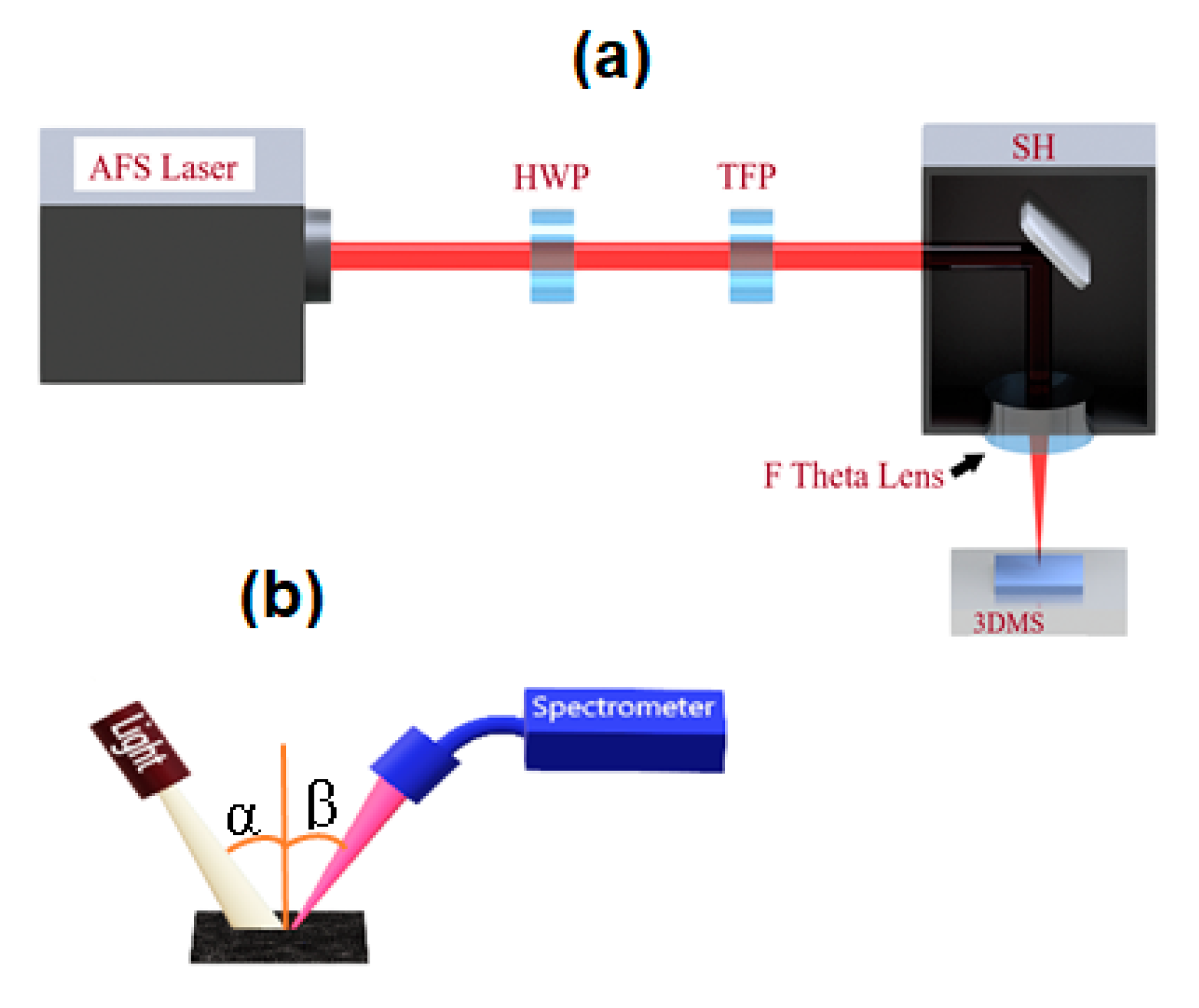
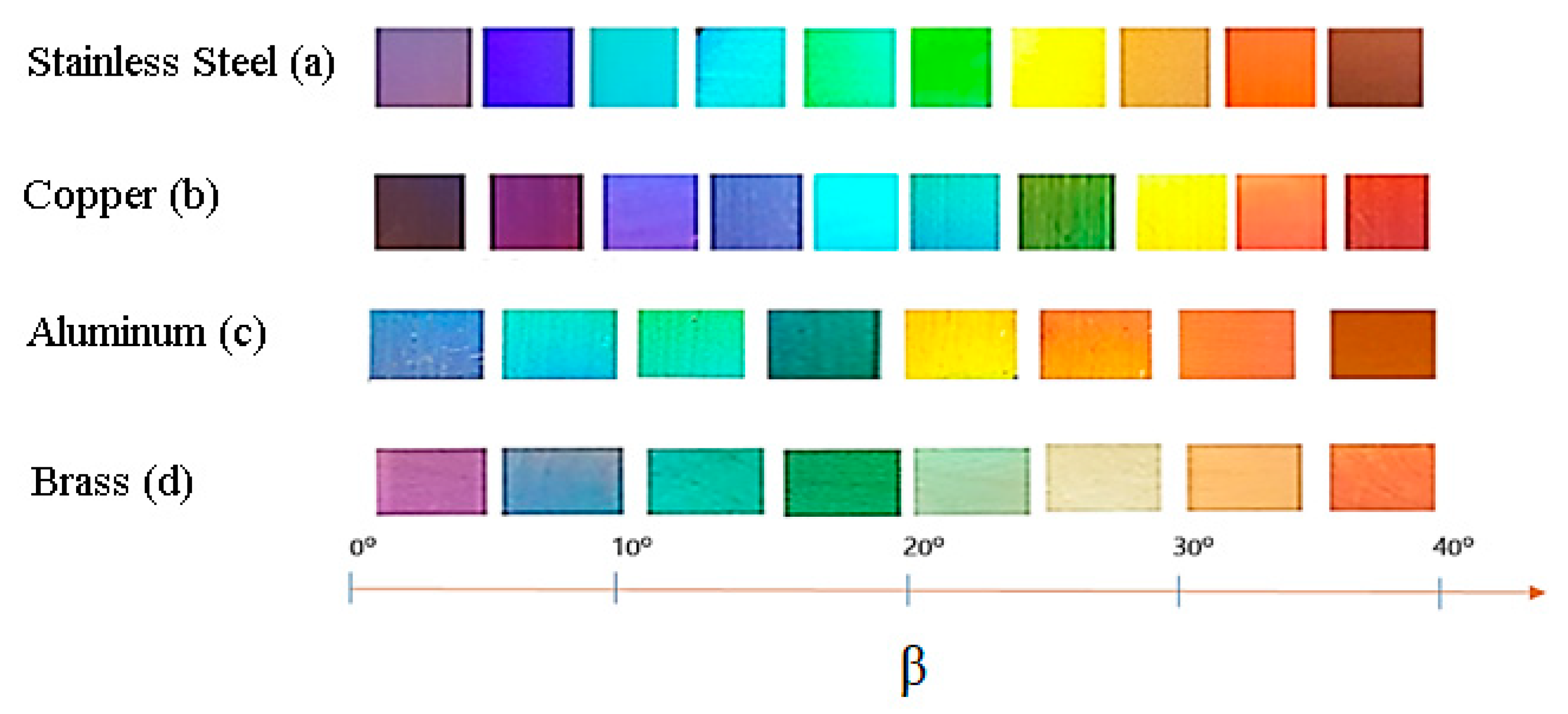

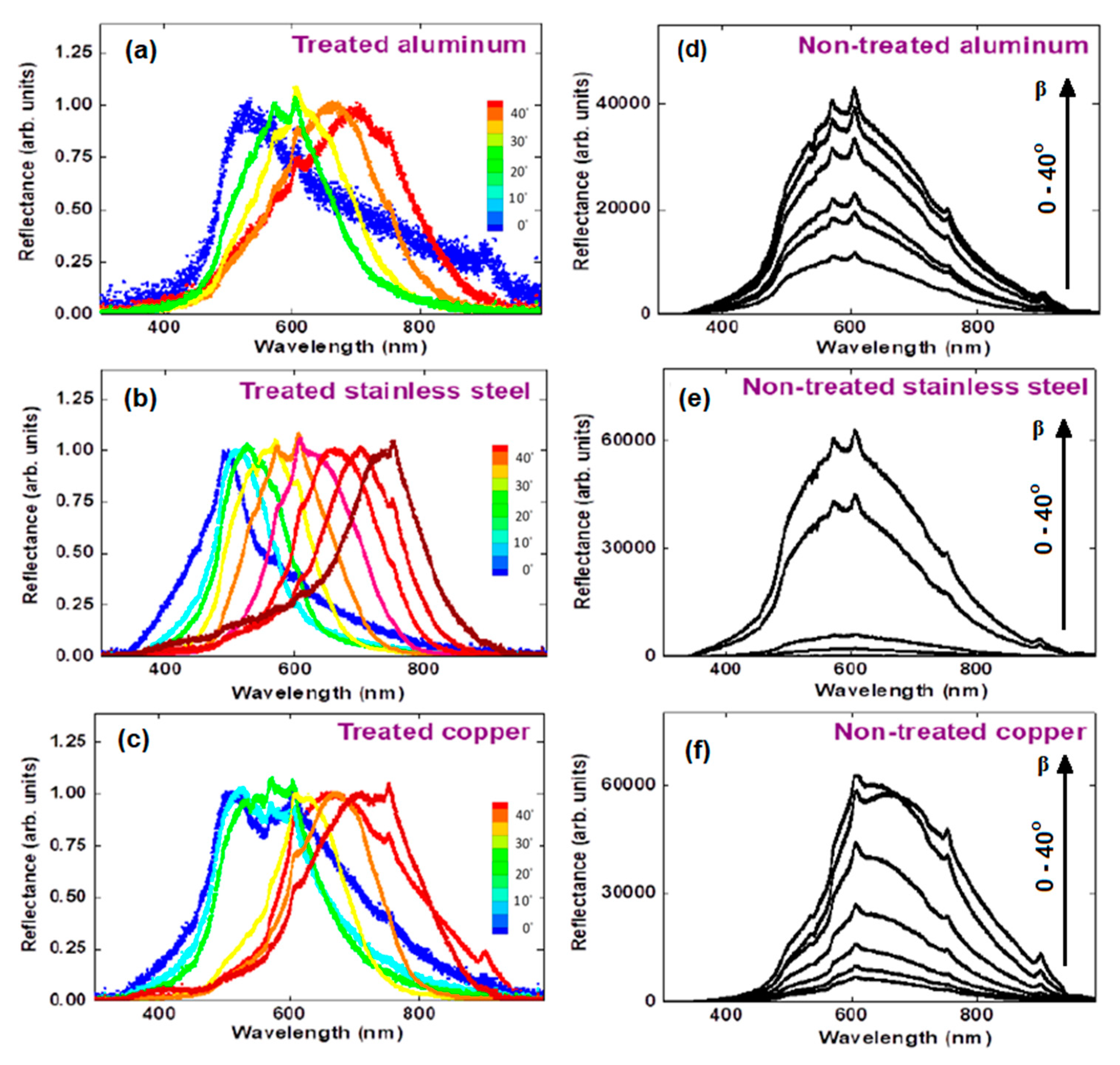
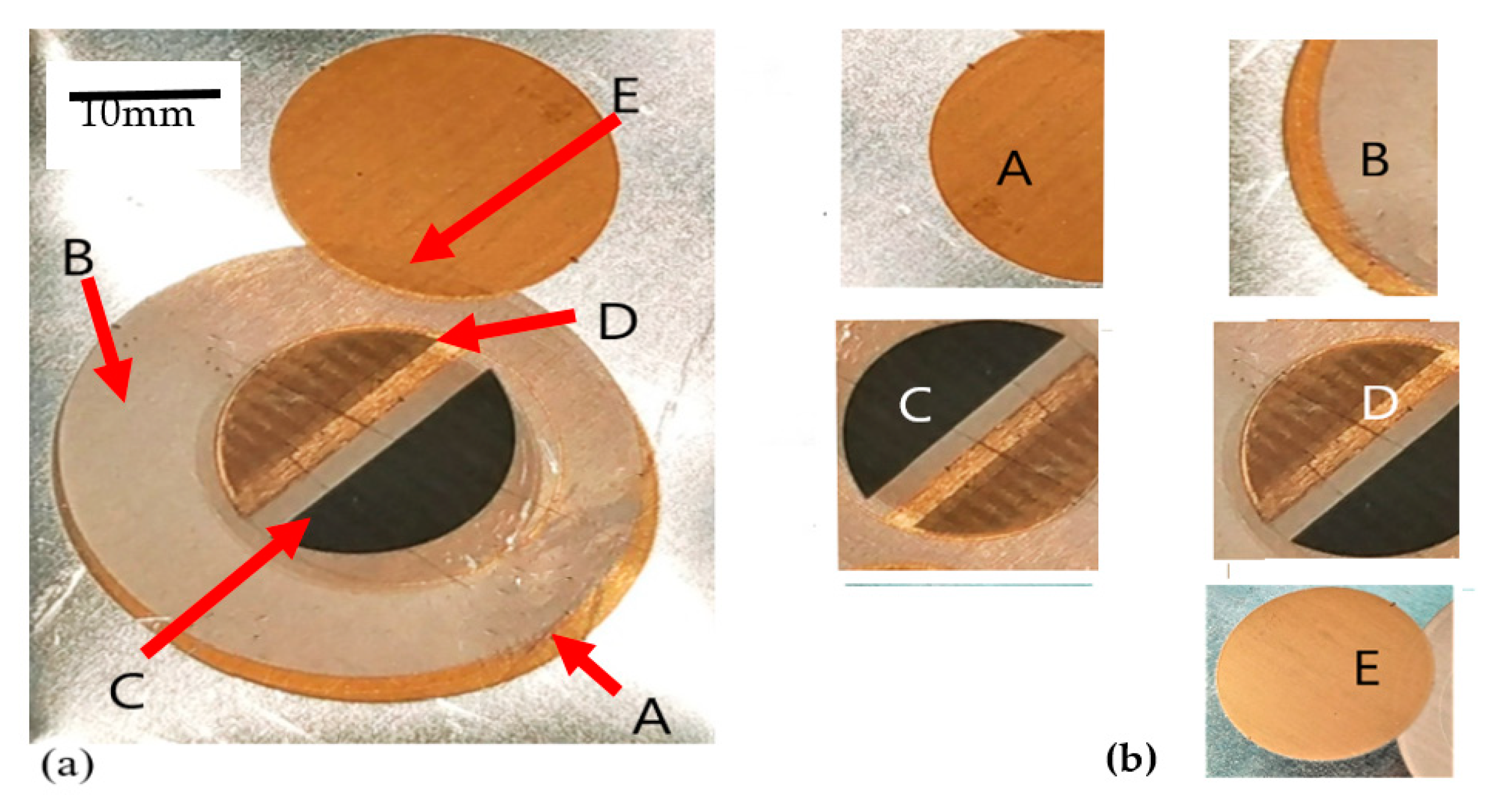

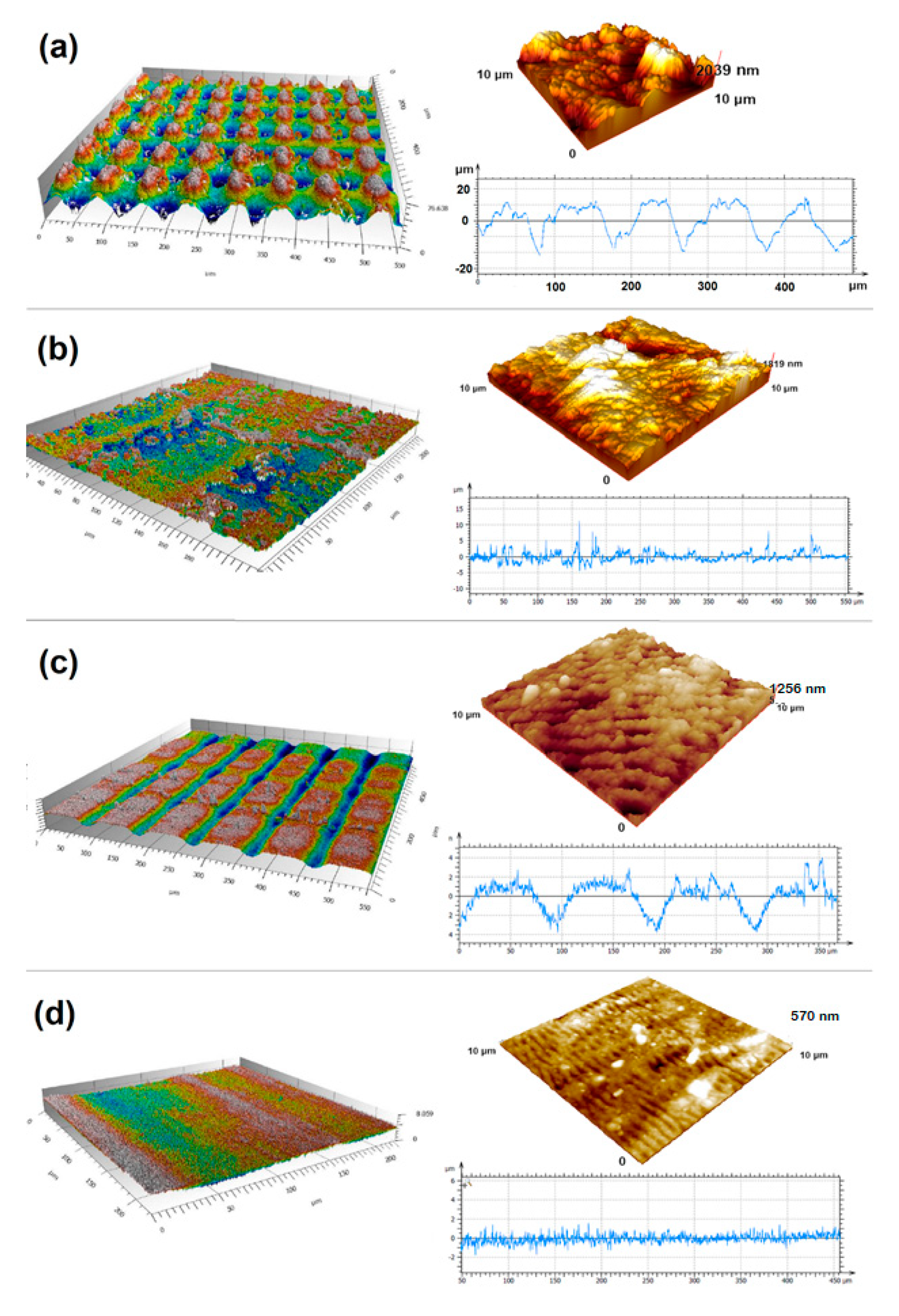
| Structures Features | Potential Application Areas | Reference |
|---|---|---|
| Hierarchical micro/nanostructures | Hydrophobicity, water collection | [35] |
| Scale-like structures | Friction reduction | [36] |
| Pillar-like, nanowires nanostructures | Anti-reflection | [37] |
| Periodic ripples, micrograting | Structural coloring, iridescence | [38,39] |
| Micro/nano spikes | Anti-corrosion, Anti-mechanical fatigue resistance | [40] |
© 2020 by the authors. Licensee MDPI, Basel, Switzerland. This article is an open access article distributed under the terms and conditions of the Creative Commons Attribution (CC BY) license (http://creativecommons.org/licenses/by/4.0/).
Share and Cite
Iqbal, M.; Ialyshev, V.; Kim, V.; Boltaev, G.; Ivanov, D.; Rethfeld, B.; Ganeev, R.A.; Alnaser, A.S. Simultaneous Manipulation of the Optical and Wettability Properties of Metal Surfaces Using 150 kHz Femtosecond Fiber Laser. Appl. Sci. 2020, 10, 6207. https://doi.org/10.3390/app10186207
Iqbal M, Ialyshev V, Kim V, Boltaev G, Ivanov D, Rethfeld B, Ganeev RA, Alnaser AS. Simultaneous Manipulation of the Optical and Wettability Properties of Metal Surfaces Using 150 kHz Femtosecond Fiber Laser. Applied Sciences. 2020; 10(18):6207. https://doi.org/10.3390/app10186207
Chicago/Turabian StyleIqbal, Mazhar, Vadim Ialyshev, Vyacheslav Kim, Ganjaboy Boltaev, Dmitry Ivanov, Baerbel Rethfeld, Rashid Ashirovich Ganeev, and Ali Sami Alnaser. 2020. "Simultaneous Manipulation of the Optical and Wettability Properties of Metal Surfaces Using 150 kHz Femtosecond Fiber Laser" Applied Sciences 10, no. 18: 6207. https://doi.org/10.3390/app10186207
APA StyleIqbal, M., Ialyshev, V., Kim, V., Boltaev, G., Ivanov, D., Rethfeld, B., Ganeev, R. A., & Alnaser, A. S. (2020). Simultaneous Manipulation of the Optical and Wettability Properties of Metal Surfaces Using 150 kHz Femtosecond Fiber Laser. Applied Sciences, 10(18), 6207. https://doi.org/10.3390/app10186207







